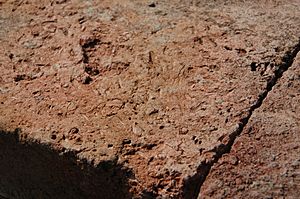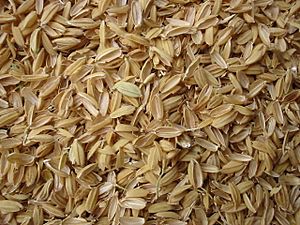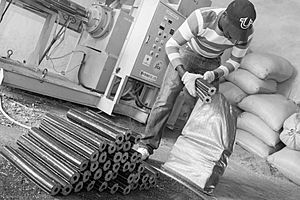Rice hulls facts for kids
Rice hulls (also called rice husks) are the tough outer coverings of rice grains. They protect the rice while it grows. After the rice is harvested, these hulls can be used in many ways. They can become building materials, fertilizer, insulation material, or even fuel. Rice hulls are a part of the chaff that is removed from the grain.
Contents
How Rice Hulls Are Made
Rice hulls are a natural part of the rice seed. They act like a shield, protecting the grain from pests during its growth. These hulls are made of strong materials like silica (which is found in sand) and lignin (a tough plant fiber).
Hulls are very hard to eat and mostly cannot be digested by humans. This is because they have a lot of fiber. Long ago in China, during times when food was scarce, people sometimes made pastries from rice husks, wild plants, and soybean powder. This shows how tough times were.
To separate the rice from its hulls, people first used a method called winnowing. They would toss the rice into the air. The wind would blow away the light hulls, while the heavier rice grains fell back down. Later, tools like pestles and a simple machine called a rice pounder were invented. These helped remove the hulls more easily. In 1885, a modern rice hulling machine was invented in Brazil. During the milling process, the hulls are taken off the raw grain. This leaves brown rice. Brown rice is then often milled more to remove its outer layer, making white rice.
Cool Uses for Rice Hulls

Rice Husk Ash
When rice hulls are burned, they turn into rice husk ash (RHA). This ash is a good source of silica, which is useful in many ways. Most of this ash is used to make Portland cement, a key ingredient in concrete. This ash is even finer than cement. This means it can make concrete very strong and compact. The ash is also a great material for keeping heat in, acting as insulation. Its fine particles can even help seal tiny cracks in buildings.
For a long time, rice husk ash has been used in ceramic glazes in places like China and Japan. Since it's about 95% silica, it's an easy way to add silica to glazes. Its small size helps the glaze melt quickly.
RHA can also be used to soak up oils and chemicals. It can improve soil for farming. It's a source of silicon and can be used as insulation powder in steel factories. It can even be used to make special materials called "whiskers" for strong cutting tools.
Toothpaste
In Kerala, India, people used charcoal from rice husks to clean their teeth for hundreds of years. This was before modern toothpaste became common.
Rice Bran Oil
Rice bran oil is made from the hard, brown outer layer of rice, which is the rice husk. It is a popular cooking oil in many Asian countries, like India, Japan, and Malaysia.
Brewing Beer
Rice hulls can be added when making beer. They help the liquid flow better during a step called lautering. Rice husks are also used in making a traditional Chinese drink called Kaoliang. They are added to the wine tank to create space, which helps with distillation.
Fertilizer and Garden Soil
Rice hulls can be turned into compost, which is great for plants. However, they break down slowly because they have a lot of lignin. Sometimes, earthworms are used to speed up this process. Using special vermicomposting methods, hulls can become fertilizer in about four months.
Rice hulls that have been parboiled (PBH) are used as a growing material for gardening. This includes some hydroponic systems, where plants grow without soil. The hulls allow water to drain well and don't hold as much water as some other materials.
Fireworks
Rice hulls are coated with fine gunpowder. They are then used as the main bursting charge inside aerial fireworks shells.
Fuel
With the right methods, rice hulls can be burned to power steam engines. Some rice mills used to get rid of hulls this way. Burning them directly can create a lot of smoke. A better way is gasification. This process turns the hulls into a gas that burns with a clean, blue flame. The leftover material, called biochar, is good for improving soil.
Traditional brickmaking kilns in the Mekong Delta region use rice hulls as fuel.
Juice Extraction
Rice hulls are used as a "press aid" to help extract more juice from apples when they are being pressed.
Pet Food Fiber
Rice hulls are a cheap byproduct from making human food. They are used as a source of fiber in pet foods. They are often considered a filler ingredient.
Pillow Stuffing
Rice hulls are used to stuff pillows. These pillows are loosely filled and are thought to be good for your head and neck because they keep their shape.
Insulating Material
Rice hulls are a great thermal insulating material. They are hard to burn and don't easily allow moisture to cause mold or fungi to grow. They are also mixed with mud and water to make roofing material.
Particle Boards and Cardboard
Rice hulls are also used to make particle boards and cardboard. The silica in rice husks makes these boards less appealing to termites.
Geopolymers
Because rice husk ash (RHA) has a lot of silica, it can be used to make a special type of concrete called geopolymer concrete.
Rice Concrete
To get the best properties for concrete, the rice husks must be burned carefully. The temperature should be kept below 700°C, and there needs to be enough air to prevent too much carbon from forming.
Adding a small amount of rice hull ash (about 2% to 3% of the cement's weight) can make concrete mixtures easier to work with. It helps prevent the cement from separating and makes the concrete stronger and last longer. However, adding too much ash can make the concrete hard to work with unless special water-reducing additives are used.



